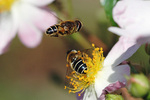Tiny insect brains capable of huge feats
 Physiology Physiology
Insects may have tiny brains the size of a pinhead, but the latest research from the University of Adelaide shows just how clever they really are. For the first time, researchers from the University's Discipline of Physiology have worked out how insects judge the speed of moving objects. It appears that insect brain cells have additional mechanisms that can calculate how to make a controlled landing on a flower or reach a food source. This ability only works in a natural setting. In a paper published recently in the international journal Current Biology, lead author David O'Carroll said insects have brain cells dedicated to analysing visual motion, which are very similar to humans. "It was previously not understood how a tiny insect brain could use multiple brain pathways to judge motion," Associate Professor O'Carroll said. "We have known for many years that they can estimate the direction of moving objects but until now we have not known how they judge speed like other animals, including humans. "It appears they take into account different light patterns in nature, such as a foggy morning or a sunny day, and their brain cells adapt accordingly. "This mechanism in their brain enables them to distinguish moving objects in a wide variety of natural settings. It also highlights the fact that single neurons can exhibit extremely complex behaviour." Associate Professor O'Carroll co-authored the paper with Paul Barnett, a Physiology PhD student at the University of Adelaide, and Dr Karin Nördstrom, a former Physiology Postdoctoral Fellow at Adelaide who is now based at Uppsala University in Sweden. Their specific research is focused on how the brain makes sense of the world viewed by the eye, using the insect visual system as an important model. "Insects are ideal for our research because their visual system accounts for as much as 30% of their mass, far more than most other animals," Associate Professor O'Carroll said. His team is collaborating with industry to develop artificial eyes in robots, mimicking human and insect vision. Story by Candy Gibson
|





